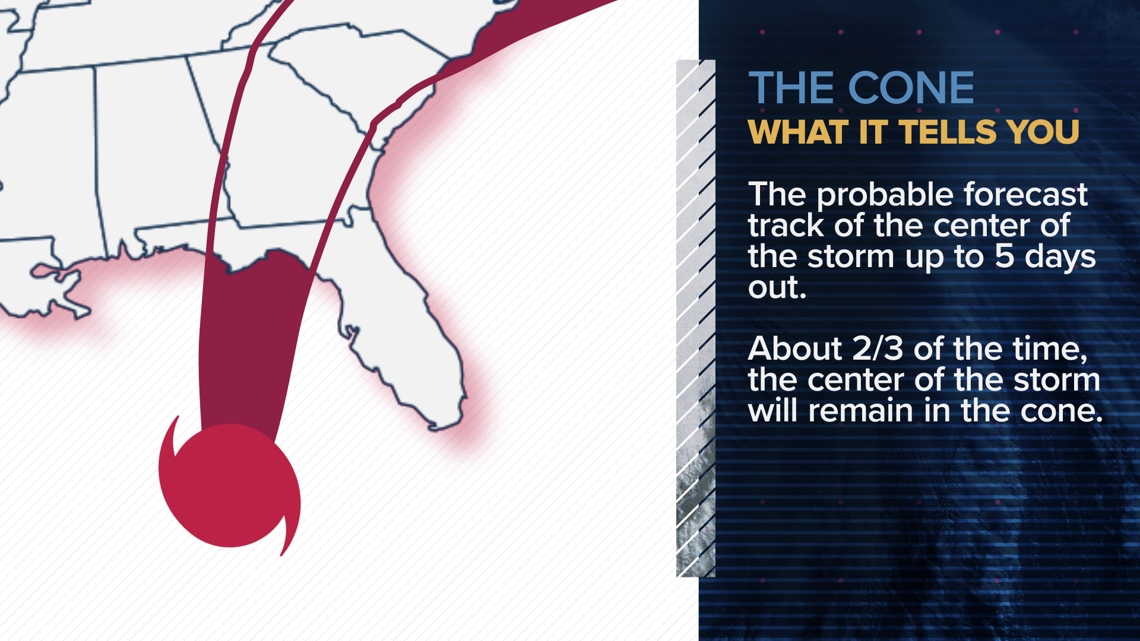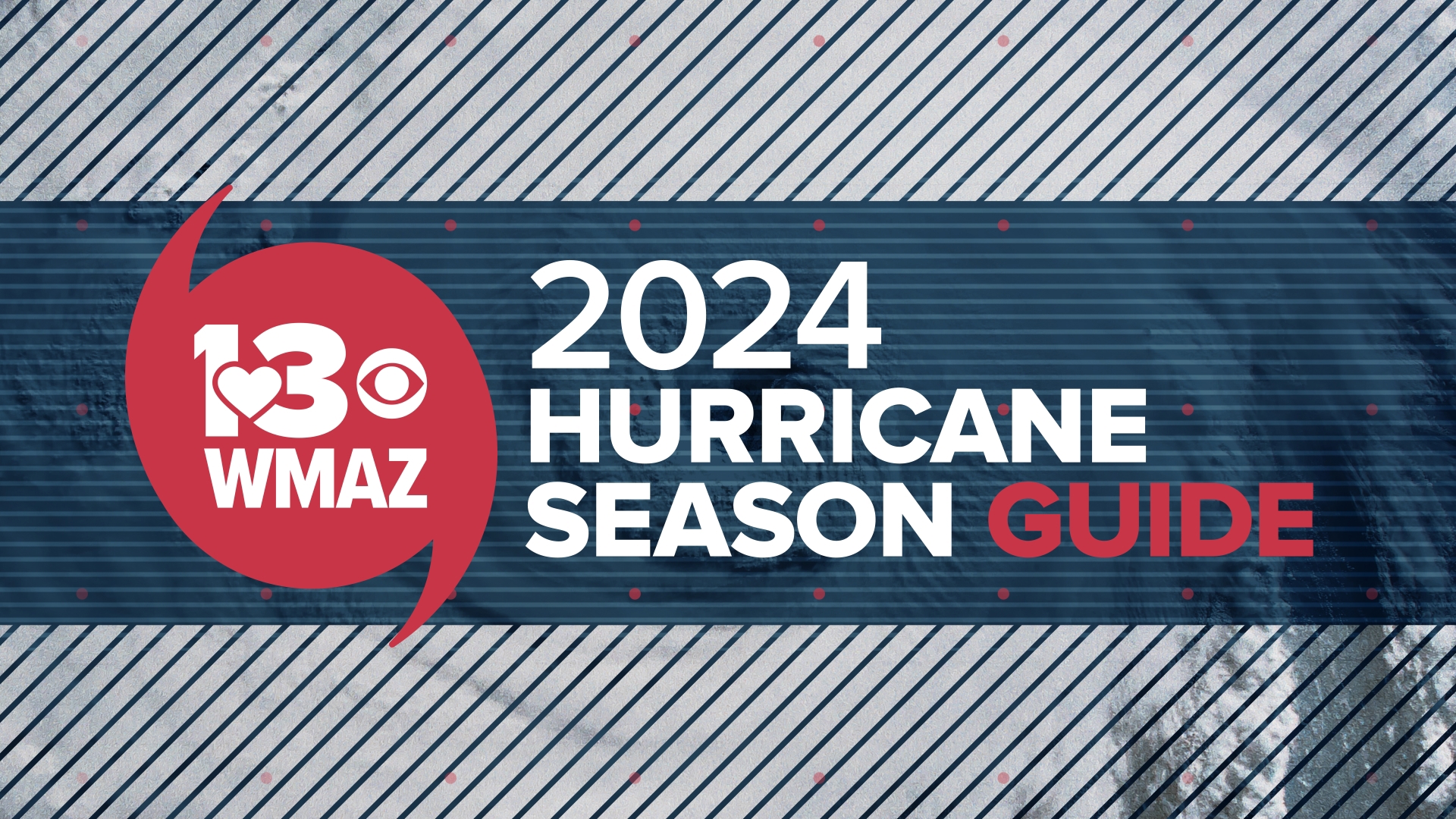2024 Hurricane Season Guide from the 13WMAZ Weather Team
Forecasters are expecting one of the most active hurricane seasons on record for 2024.

The 2024 hurricane season is here and forecasters are expecting it to be an active year. The combination of warm sea surface temperatures and a lack of wind shear is setting the stage for ripe tropical development conditions.
2024 FORECAST Here's a look at this year's forecast
Forecasters are expecting 2024 to be an active season as La Niña takes hold in the Pacific waters by the peak of hurricane season. The water temperatures in the equatorial Pacific Ocean play an important role in the conditions over the tropical Atlantic.
NOAA forecasters are predicting 17-25 named storms. Of those, forecasters expect 8-13 to become hurricanes and 4-7 to reach major hurricane strength, with sustained winds of 111 miles per hour or greater. The university has been issuing forecasts for forty-one years and this is the most ambitious forecast released before a season.
"The forecast for named storms, hurricanes, and major hurricanes is the highest forecast NOAA has ever issued for the May outlook," said NOAA Administrator Rick Spinrad.
Colorado State University's researchers are predicting 23 named storms. Of those, researchers forecast 11 to become hurricanes and 5 to reach major hurricane strength. The university has been issuing forecasts for forty-one years and this is the most ambitious forecast released before a season.
Colorado State has a long history of reliable forecasts. However, they do emphasize that the forecast is intended to provide a best estimate of activity in the Atlantic during the upcoming season, not an exact measure.
Winds over the northern Atlantic will not be strong, which hinders the development of wind shear. Tropical cyclones need as little wind shear as possible to develop and strengthen. Additionally, the sea surface temperatures in the Atlantic are already trending warmer than normal, adding fuel for the season ahead.
STORM NAMES Here's a look at the storm names for this year
- Alberto
- Beryl
- Chris
- Debby
- Ernesto
- Francine
- Gordon
- Helene
- Isaac
- Joyce
- Kirk
- Leslie
- Milton
- Nadine
- Oscar
- Patty
- Rafael
- Sara
- Tony
- Valerie
- William
Francine and Milton are new to the list, last used in 2018. The names replace Florence and Michael.
Supplement Names
If we go over the 21 names available this year, we will start back at the letter "A" with the National Hurricane Center's Supplement Names list. This would be the first time we use this list of names, as the last time we ran over in 2020 we used the Greek alphabet.
- Adria
- Braylen
- Caridad
- Deshawn
- Emery
- Foster
- Gemma
- Heath
- Isla
- Jacobus
- Kenzie
- Lucio
- Makayla
- Nolan
- Orlanda
- Pax
- Ronin
- Sophie
- Tayshaun
- Viviana
- Will
Hurricane Florence
The name Florence was retired after the 2018 hurricane made landfall in the Carolinas, bringing heavy rain for days. The weakening hurricane produced rainfall exceeding 10 inches across a large swath of North Carolina and South Carolina.
The maximum rainfall total during Florence set a state tropical rainfall record near Elizabethtown, North Carolina, totaling 35.93 inches. In South Carolina, a state tropical rainfall record was set near Loris at 23.63 inches.
According to the USGS, 33 river gauges set record high crests as a result of the hurricane.
Hurricane Michael
The name Michael was retired after the category 5 hurricane made landfall in the Florida panhandle, near Mexico Beach. It caused widespread tree damage and power outages as well as severe crop damage, especially to cotton and pecan crops right here in central Georgia.
We also saw tropical tornadoes from the hurricane's outer bands in Peach and Crawford Counties.
At least 79 deaths were blamed on Michael, including 59 in the United States. It's total economic impact was estimated at $25.5 billion dollars, according to the National Centers for Environmental Information.
2023 RECAP Here's a look back at last year's hurricane season
2023 was a relatively quiet year for the United States. Only one storm came ashore as a hurricane (Idalia) and two storms came ashore at tropical storm status (Harold and Ophelia).
Idalia was the August hurricane that made landfall as a category 3 in the sparsely-populated Big Bend region of Florida. In Georgia, flash flooding and tornadoes were the main impacts of the storm. A man was killed in Valdosta when a tree fell as he helped sheriff's deputies clear storm debris.
Governor Brian Kemp said at the time that the state took on at least $41 million in damage to public infrastructure in Georgia. Agricultural Commissioner Tyler Harper also said that the peanut industry was heavily impacted.
THE CONE Here's a look at what the forecast cone is
The iconic forecast cone shows the potential track for the center of a tropical cyclone. The National Hurricane Center uses forecast errors from past years to determine the cone's width at different forecast times. The storm is expected to stay in the cone two-thirds of the time and track outside of the cone one-third of the time.


It is important to note that the cone does not take into account the size of the storm or the impacts that will occur. In every cone, impacts will reach far beyond the boundaries of the days 1-3 forecast.


Bottom line, the cone does not show where impacts are expected, only the where the center is forecasted to go. Even then, the expectation is that the center stays within the cone only two-thirds of the time.
TERMS TO KNOW Here's what you need to know
Hurricane: A tropical cyclone in which the maximum sustained surface wind is 74 mph or more.
Major Hurricane: A hurricane that is classified as Category 3 or higher.
Tropical Storm: A tropical cyclone in which the maximum sustained surface wind speed ranges from 39 mph to 73 mph.
Tropical Depression: A tropical cyclone in which the maximum sustained surface wind speed is 38 mph or less.
Potential Tropical Cyclone: A term used in NWS advisory products to describe a disturbance that is not yet a tropical cyclone, but which poses the threat of bringing tropical storm or hurricane conditions to land areas within 48 hours.
Rapid Intensification: An increase in the maximum sustained winds of a tropical cyclone of at least 35mph in a 24-hour period.
Landfall: The intersection of the surface center of a tropical cyclone with a coastline. Because the strongest winds in a tropical cyclone are not located precisely at the center, it is possible for a cyclone's strongest winds to be experienced over land even if landfall does not occur. Similarly, it is possible for a tropical cyclone to make landfall and have its strongest winds remain over the water.
Saffir-Simpson Hurricane Wind Scale: The Saffir-Simpson Hurricane Wind Scale is a 1 to 5 categorization based on the hurricane's intensity at the indicated time. The scale provides examples of the type of damage and impacts in the United States associated with winds of the indicated intensity.
- Category 1: 74-95 mph
- Category 2: 96-110 mph
- Category 3: 111-129 mph
- Category 4: 130-156 mph
- Category 5: 156 mph+
The strongest part of any tropical system will always be around the eye or center. For example, if you have a category 4 hurricane coming ashore, the category 4-force winds will only be felt in a small area around the eye. The winds get gradually weaker the further out you get.


